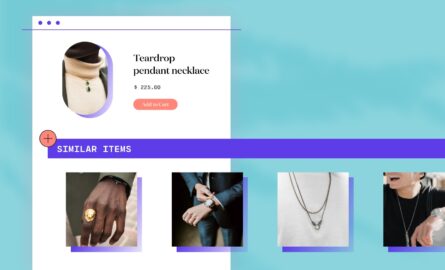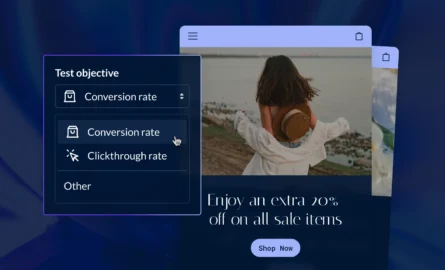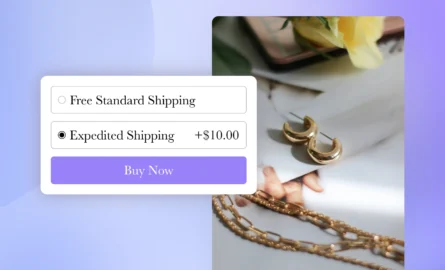Amazon Prime Day 2023: How to Prep Your Store For Success

There are three things you need to know about Amazon Prime Day. It moves inventory, it moves fast—and this year, it has moved dates once again.
While originally, Prime Day took place on a single day, it’s actually a two-day event. Amazon uses this event (and the uncertainty of its timing) to drive people to buy the deals.
And there are a lot of deals.
But you don’t have to sell on Amazon to have Prime Day act like rocket fuel for your direct-to-consumer store. You only need to know how to position your store’s offers to leverage shoppers’ excitement.
Skip ahead:
#cta-visual-pb#<cta-title>Build special offer landing pages that convert<cta-title>Create and customize landing pages with all the vital elements for conversions—all without code.Start designing for free
When is Amazon Prime Day 2023?
It was just announced that Amazon Prime Day will be happening on July 11-12 this year, getting back to their pre-pandemic schedule of scheduling it as a sort of anniversary of Amazon’s founding.
Amazon plays it very close to the chest with the dates of Prime Day. Last year, it was on June 12-13. In 2020—in response to the pandemic—it got pushed back to October 13-14.
With the 2023 dates now confirmed, brands will have a few weeks to prepare.
Similar to the last few Prime Day events, this year’s sale will span two consecutive days and offer millions of deals across each department.
This year they are introducing their Invite-only deals program, giving Prime members the chance to sign up for the best deals that may sell out.
The special deals have already started this week, with big discounts on Amazon-branded products.
Why such short notice? Amazon may want to keep us on our toes.
We’ve gotten used to the idea that Black Friday is the same time every year, always the day after Thanksgiving. But Amazon keeps things less predictable.
There’s no need to panic about the quick turnaround.
The critical question isn’t so much when it is, or even what you’ll sell. It’s why your store needs to be ready, and how to best prepare.
Why should DTC brands bother with Amazon Prime Day?
If you sell products on Amazon, this is simple.
Shoppers will have their wallets out and their clicking fingers in position. A smart Amazon seller will prep accordingly.
But what if you’re not yet selling on Amazon directly?
No worries, you can still take advantage!
The Prime Day “Halo Effect”
Amazon Prime Day is such a potent market-mover that it spills over to the rest of the Internet. Experts have dubbed this the “Prime Day Halo Effect.”
It’s both real and measurable.
According to ROI Revolution and The Current, retailers outside of Amazon saw their own boosts during Prime Day 2022:
- 40% of Prime Day shoppers also purchased from another retailer
- Compared with 2021’s Prime Day, there was an 8% growth in US sales for other retailers
That leaves one question: how can an off-Amazon retailer capitalize?
According to Megan Barry, the best way is simply to recognize Prime Day’s relevance and position your next store promotion accordingly:

“Merchants who don’t sell on Amazon can capitalize on consumers’ increasing desire to shop from independent brands. By explicitly putting your sales/promotions on Prime Day, you can drive consumer spending to your store vs. Amazon. You can leverage messaging around supporting small businesses or even an ‘anti-Prime Day’.”
— Megan Barry, VP of Product at OctaneAI
Working on the Amazon platform
Even with the halo effect doing wonders for non-Amazon retailers, Amazon Prime Day 2023 is a stellar platform for growth.
There are now over 200 million Prime members across 19 countries. And nearly 2 million small and medium-sized businesses are already on Amazon.
There’s enough participation in Prime Day, you can think of it as a miniature Black Friday.
While the sales revenue primarily benefits Amazon, small and medium businesses do just as well or even better: third-party sellers saw an 11.7% increase in sales from 2021 to 2022, compared to Amazon’s 6.1% boost on their own product lines.
Take the example of Furbo, the dog camera. Though the company only started selling on Amazon in 2016, a “spotlight deal” placement on Prime Day in 2020 gave the company jet fuel.
Within a year, they were the top-selling pet camera in the world. On Prime Day, they saw sales increases of 500x their daily average.
#cta-paragraph-pb#Want to start selling on Amazon ahead of Prime Day? Shopify brands can easily add Amazon as a sales channel for extra sales, especially during Prime Day. Check out our guide to selling on Amazon with Shopify to get the best of both worlds.
Navigating this year’s Amazon Prime Day
Whether or not your company will be selling on Amazon on Prime Day, it doesn’t hurt to know what sells.
The more you know the trends, the more you can leverage your own deals in these ecommerce verticals and receive potential boosts from the Amazon halo effect.
Here’s what often sells, if the recent past is any indication:
- Consumer electronics. Amazon loves to slash prices on Echoes, Kindles, and Fire TVs to build customer loyalty. These devices often go half-off and can set off a frenzy for other consumer electronics.
- Appliances. Home automation was popular last year, including items like smart plugs and Instant Pots among the top sellers.
- Personal care. Teeth-whitening strips are a traditional Prime Day favorite. Last year, Waterpiks and pillows were among the top sellers, too.
If these trends overlap with your store…
Remember, Amazon can be a friend just as much as it can be a competitor.
It may be time to consider steep discounts when possible to either beat out Prime Day or divert some Prime Day traffic your way.
Customers will be on the hunt for what you sell. Consider creating new bundles that help create discounts on some of these products.
Or run a flash sale on these items after Amazon Prime Day for anyone who feels like they missed out.
Consider boosting ad spend on electronics, appliances, and personal care to catch some of the traffic that would otherwise go Amazon’s way. (More on this later.)
What’s trendy with Amazon Prime Day is that customers know they don’t have to go to Amazon to find sales.
Shopify-based and independent DTC stores are happy to position their sales to coincide with the spikes in traffic.
Especially when customers are already in “must-shop-now” mode.
How to prep your store for Amazon Prime Day
There are a few powerful ways you can take advantage of all the online shopping happening during Prime Day.
It helps to take notes from Amazon and apply them to your own store. Try these strategies to get those sales.
Free two-day shipping
90% of consumers say free shipping is a top incentive for their buying decisions.
It’s especially important for Prime members, where two-day shipping is a major selling point. Seeing your $4.99 shipping fees can inevitably be a disappointment.
Do what you can to minimize that effect.
How? First, it pays to offer two-day shipping when possible. This usually means you have to pay a premium.
Shopify recommends limiting your offerings to store members or making them after a minimum order value. They also feature a calculator for figuring out when the cost of two-day shipping will be well worth the additional sales you make.
If you do offer free shipping, advertise it.
Consider a badge that highlights your two-day offerings, especially if it incentivizes a minimum order value.
“Combined with free shipping, this can be a big needle-mover for you,” said Amanda Natividad, Head of Content at ShipBob.
For example, offering a free shipping threshold that’s 10-20% higher than your average order value (AOV) can make the investment worth it.
According to Natividad, ShipBob’s customers have seen an 18% reduction in cart abandonment and a 97% increase in AOV while offering free two-day shipping.
It’s worth the investment.
Flash/lightning sales
One reason people flock to Prime Day and Black Friday isn’t because they always have a specific product in mind.
It’s the exciting concept of a deal that attracts them.
Flash and lightning sales are perfect for customers who are already in deal-hunting mode. And since there can be substantial fees in creating your own flash sale on Amazon, this can be even more profitable on your own.
Consider cashing in on the halo effect by offering the following:
- Exclusive “Before Prime Day” sales, i.e., “Get the latest before Prime Day!”
- “Missed Prime Day?” Deals.
- Using a countdown timer to highlight just how quickly the flash sale will move. This creates urgency for customers who are already in a hurry.
- Create a dedicated landing page for your flash sale. This builds credibility: when a customer lands on a unique URL custom to a deal, it highlights the urgency of the sale. This is especially easy to do with Shogun Page Builder.

“Teaching your customers to anticipate these super sales (and being disciplined about other discounting) will — I believe —garner the same excitement or more, since presumably it’s excitement and brand loyalty coming together…which Amazon likely won’t have anytime soon. The issue is — it takes awhile to take up that much space in your customers’ minds.”
— Rachel Thaw, Founder of Harper Coats
#cta-mini-pb#Make your next store promotion convert! Learn how to build persuasive special offer pages from the brands who’ve perfected them.Download the ebook
Bundle sales
The same principle is at work when you bundle sales. Customers like the idea of bargain-hunting and landing on an exclusive offer.
When you do offer bundle sales, consider the following:
- Run side-by-side comparisons with the original prices of your products to highlight the deal, the same way Amazon displays slashed prices.
- Consider a third-party logistics operator like ShipBob that can automatically put bundle items into one package, requiring no extra work on your end.
- Create multiple bundles, highlighting them on your front page with three options side-by-side. The one in the middle is your target sale. One study found we tend to have a bias toward the middle choice, when we see it laid out visually.
Get ready
Amazon Prime Day is coming quickly this year, which gives you less time to prepare.
But if you do prep, you may just find a positive spike in your retail traffic when Prime Day hits! Ready your store, and you’ll reap the benefits of the halo effect.
#cta-visual-pb#<cta-title>Make the most of your store’s limited-time deals<cta-title>Add a countdown timer to your custom store page today—see all available drag-and-drop elements in Shogun’s Elements library.Get started for free today

Kaleigh Moore
Kaleigh Moore is a freelance writer specializing in ecommerce content. She also contributes to publications like Forbes and Vogue Business on topics around fashion and retail.



